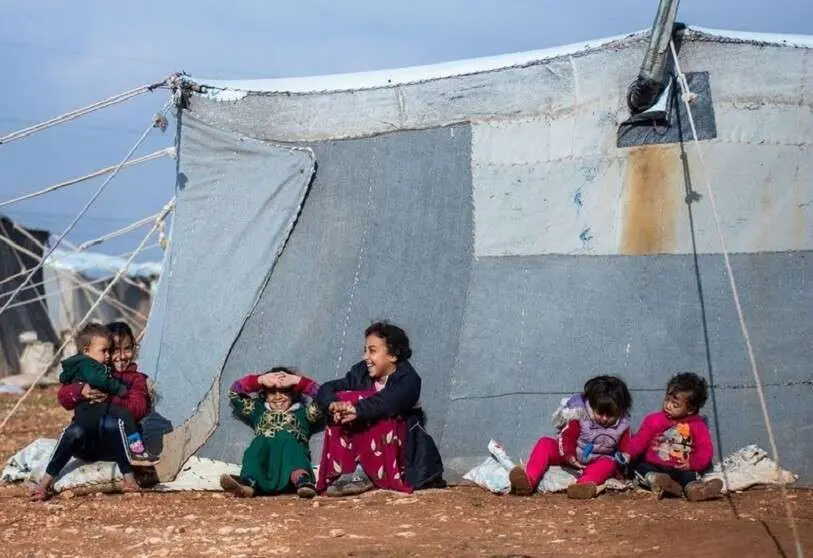Record number of displaced people in the world will continue to rise if conflicts are not resolved

"Every year of this past decade, the numbers have increased," said High Commissioner for Refugees Filippo Grandi. "Either the international community comes together to act on this human tragedy, resolve conflicts and find durable solutions, or this terrible trend will continue."
Today, one in 78 people in the world is displaced - a "dramatic milestone" that few would have imagined a decade ago, UNHCR said.
By the end of 2021, the number of people displaced by war, violence, persecution and human rights abuses stood at 89.3 million, according to the agency's annual Global Trends report.
This is an 8% increase over 2020 and "more than double the number from ten years ago", according to the report's authors, who attribute last year's rise to the escalation of numerous conflicts "and the emergence of new ones".
Since then, Russia's invasion of Ukraine - which triggered one of the largest and fastest-growing forced displacement crises since World War II - and other emergencies, from the African continent to Afghanistan and elsewhere, have pushed the figure past the dramatic milestone of 100 million people.

Food insecurity
This figure was reached in May, ten weeks after Russia's invasion of Ukraine caused a global shortage of grain and fertiliser, as both countries are major exporters.
Speaking at a press conference in Geneva, Grandi said the current global food insecurity crisis could undoubtedly push more people from their homes.
"If you have a food crisis on top of war, human rights (violations), climate...; it will simply accelerate the trends that are described in this report and that we have seen precipitating already in the first few months of the year," he said.
Conflict-induced displacement
According to the World Bank, the past year has been characterised by the number of new conflicts that have emerged and the number of existing conflicts that have been exacerbated. 23 countries - with a combined population of 850 million people - experienced medium- and high-intensity conflicts.
Of the 89.3 million displaced worldwide last year, 27.1 million were refugees: 21.3 million under the mandate of UNHCR and 5.8 million Palestinians under the care of UNRWA.
A further 53.2 million were internally displaced, 4.6 million were asylum seekers and 4.4 million were Venezuelans (although if migrants are added, they number 6.1 million).

Host countries
Data from the UNHCR report underlines the crucial role played by developing countries in hosting displaced persons, with low- and middle-income countries hosting more than four out of five of the world's refugees.
With 3.8 million refugees within its borders, Turkey hosts the largest number of refugees, followed by Colombia with 1.8 million (mostly Venezuelans), Uganda and Pakistan (1.5 million each) and Germany (1.3 million).
In relation to their national populations, the Caribbean island of Aruba hosted the largest number of Venezuelans displaced abroad (one in six), while Lebanon hosted the largest number of refugees (one in eight), followed by Curaçao (one in 10), Jordan (one in 14) and Turkey (one in 23).

Misery for millions
Among the major new humanitarian crises highlighted in 2021, UNHCR noted that conflict in Ethiopia's Tigray region displaced at least 2.5 million more people within their country, of whom 1.5 million returned home during the year.
In Afghanistan, the Taliban takeover of Kabul in August 2021 led to displacement within the country and to neighbouring nations. The number of internally displaced persons increased for the 15th consecutive year, according to UNHCR, although more than 790,000 Afghans returned during the year.
Finally, the Democratic Republic of Congo, Nigeria, South Sudan, Syria and Yemen saw increases of between 100,000 and 500,000 IDPs in 2021.

Glimmers of hope
The speed and scale of forced displacement continues to outstrip available solutions - such as return, resettlement and local integration - for displaced people.
However, UNHCR's report also shows glimmers of hope.
In 2021, returns of refugees and IDPs increased, returning to pre-COVID-19 levels, and voluntary repatriation increased by 71%, although the figure remains modest.
Also, while the number of stateless persons increased slightly in 2021, around 81,200 persons acquired a nationality or had their nationality confirmed, the largest annual reduction in statelessness cases since 2014.
"While we are witnessing the emergence of new and shocking refugee situations, while others are reactivated or remain unresolved, there are also examples of countries and communities working in coordination to find solutions for displaced persons," Filippo Grandi added.

Displacement in the Americas
There are examples of good practice in the Americas region. "Of all the refugees and forcibly displaced people in the world, one fifth are in the Americas," said José Samaniego, director of UNHCR's regional office for the Americas. "The efforts of countries in the region to regularise, provide protection and integrate these people locally are examples of solidarity that require greater support from the international community".
In 2021, there were 6.1 million refugees, migrants and asylum seekers from Venezuela worldwide (according to information provided by the Interagency Coordination Platform for Refugees and Migrants in Venezuela).
With regard to asylum applications, 1.4 million new applications were registered. Three of the top five countries with the most applications are in the Americas: the United States of America received the highest number of individual applications (188,900), followed by Germany (148,200), Mexico (132,700), Costa Rica (108,500) and France (90,200).
Four of the 10 countries of origin with the highest number of asylum seekers are in Latin America and the Caribbean: Nicaragua (two), Venezuela (four), Haiti (fifth), and Honduras (sixth). By the end of 2021, there were more than 1.1 million refugees and asylum seekers from El Salvador, Honduras and Guatemala worldwide. Asylum applications filed by persons from Nicaragua in 2021 were five times higher than the previous year.









